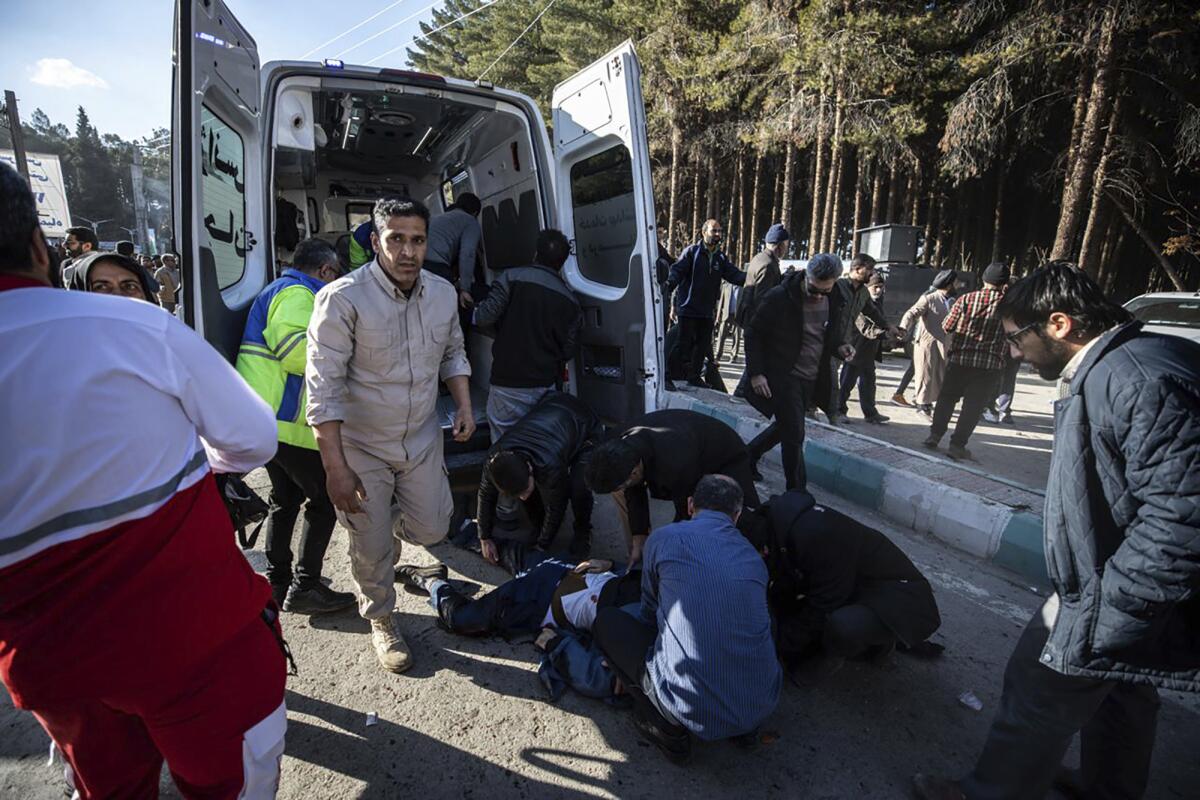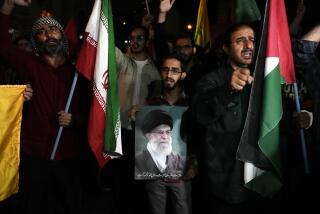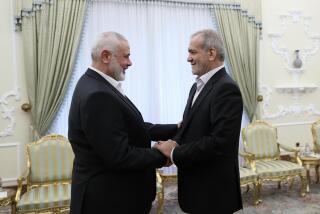Iran says at least 95 killed in blasts at ceremony honoring slain general

- Share via
DUBAI — Two bombs exploded and killed at least 95 people Wednesday at a commemoration for a prominent Iranian general slain by the U.S. in a 2020 drone strike, Iranian officials said, as the Middle East remains on edge over Israel’s war on Hamas in the Gaza Strip.
No one immediately claimed responsibility for what appeared to be the deadliest militant attack to target Iran since its 1979 Islamic Revolution. Iran’s leaders vowed to punish those responsible for the blasts, which wounded at least 211 people.
The blasts were minutes apart and shook the city of Kerman, about 510 miles southeast of the capital, Tehran. The second blast sprayed shrapnel into a screaming crowd fleeing the first explosion.
An earlier death toll of 103 was revised lower after officials realized that some names had been repeated on a list of victims, Iran’s health minister, Bahram Einollahi, told state TV. Many of the wounded were in critical condition, however, so the death toll could rise.
The gathering marked the fourth anniversary ofthe killing of Gen. Qassem Suleimani, the head of the Islamic Revolutionary Guard’s elite Quds Force, in a U.S. drone strike in Iraq. The explosions occurred near his gravesite as long lines of people gathered for the event.
Iranian state television and officials described the attacks as bombings, without immediately giving clear details of what happened. The attacks came a day after a deputy head of the Palestinian militant group Hamas was killed in a suspected Israeli strike in Beirut.
The first bomb Wednesday was detonated around3 p.m., and the other went off about 20 minutes later, the Iranian interior minister, Ahmad Vahidi, told state television. He said the second blast killed and wounded the most people.
Images and video shared on social media appeared to correspond with the accounts of officials, who said the first blast occurred about 760 yards from Suleimani’s grave in the Kerman Martyrs Cemetery near a parking lot. The crowd then rushed west along Shohada Street, where the second blast struck a little over half a mile from the grave.
A delayed second explosion is often used by militants to inflict more casualties by targeting emergency personnel responding to an attack.
Iranian state TV and the state-run Islamic Republic News Agency quoted casualty numbers provided by emergency officials. Authorities said Thursday would be a national day of mourning.
Iranian Supreme Leader Ayatollah Ali Khamenei said the attackers will face “a harsh response,” though he didn’t name any possible suspects. President Ebrahim Raisi said, “Undoubtedly, the perpetrators and leaders of this cowardly act will soon be identified and punished.”
Iran has multiple foes that could be behind the assault, including exile groups, militant organizations and state actors.
Although Israel has carried out attacks in Iran over its nuclear program, it has conducted targeted assassinations, not mass casualty bombings. A U.S. State Department spokesman, Matthew Miller, said American officials had “no reason” to believe Israel was involved in Wednesday’s attack.
Sunni extremist groups including Islamic State have conducted large-scale attacks that killed civilians in Shiite-majority Iran, though not in relatively peaceful Kerman.
Iran also has seen mass protests in recent years, including those over the death of 22-year-old Mahsa Amini in 2022. The country alsohas been targeted by exile groups in attacks dating to the turmoil surrounding the Islamic Revolution.
Iran has been arming militant groups over the decades, including Hamas, the Lebanese Shiite militia Hezbollah and Yemen’s Houthi rebels. As Israel wages its devastating war in Gaza after Hamas miltants’ Oct. 7 cross-border attack that Israel says killed at least 1,200 people and saw some 240 taken hostage, both Hezbollah and the Houthis have launched attacks targeting Israel that they say are on behalf of the Palestinians.
Israel is suspected of launching the Tuesday attack that killed a deputy leader of Hamas in Beirut, but that attack caused limited casualties in a densely populated neighborhood of the Lebanese capital. Last week, a suspected Israeli strike killed a Revolutionary Guard commander in Syria.
A Houthi spokesman, Mohammed Abdel-Salam, sought to link the bombings to Iran’s “support for the resistance forces in Palestine and Lebanon,” though he did not specifically blame anyone for the attack.
In Beirut, Hezbollah leader Hassan Nasrallah called the people who died in the attacks “martyrs who died on the same road, cause and battle that was led by” Suleimani.
The government of neighboring Iraq expressed condolences, and the European Union issued a statement offering “its solidarity with the Iranian people.”
Suleimani was the architect of Iran’s regional military activities and is hailed as a national hero among supporters of Iran’s theocracy. He also helped secure Syrian President Bashar Assad’s government after the 2011 protests against him turned into a civil, and later a regional, war that still rages today.
Relatively unknown in Iran until the 2003 U.S.-led invasion of Iraq, Suleimani grew in popularity and mystique after American officials called for his killing over his help arming militants with penetrating roadside bombs that killed and maimed U.S. troops.
A decade and a halflater, Suleimani had become Iran’s most recognizable battlefield commander, ignoring calls to enter politics but growing as powerful as, if not more than, its civilian leadership.
Ultimately, a drone strike launched by the Trumpadministration killed the general, part of escalating incidents that followed America’s 2018 unilateral withdrawal from Tehran’s nuclear deal with worldpowers.
Suleimani’s death has drawn large processions in the past. At his funeral in 2020, a stampede broke out in Kerman as thousands thronged the procession, killing at least 56 people and injuring more than 200.
Until Wednesday, the deadliest attack to strike Iran since the revolution was the 1981 truck bombing of the Islamic Republican Party’s headquarters in Tehran. That attack killed at least 72 people, including the party’s leader, four government ministers, eight deputy ministers and 23 lawmakers.
In 1978, just before the revolution, an intentionally set fire at the Cinema Rex in Abadan killed hundreds of people.
Associated Press writers Amir Vahdat and Nasser Karimi in Tehran; Suzan Fraser in Ankara, Turkey; Bassem Mroue in Beirut; and Jack Jeffery and Emma Burrows in London contributed to this report.
More to Read
Sign up for Essential California
The most important California stories and recommendations in your inbox every morning.
You may occasionally receive promotional content from the Los Angeles Times.










